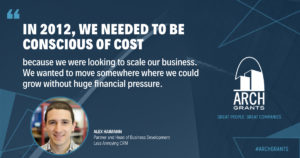
How Startup Funding Works And Why We’ve Decided To Bootstrap

Writing by Tyler King. Tyler is the co-founder and CEO of Less Annoying CRM (“LACRM”), a St. Louis-based software startup that makes customer relationship management software specifically for small businesses.
When my brother and I started Less Annoying CRM, we decided to bootstrap. If you’re not familiar with the term, that means that the founders (i.e. my brother and I) funded the company entirely by ourselves, without any financial help from outside investors.
The decision of whether or not to raise money from investors is a huge and very difficult one for most startups, so I figured I’d write down my thoughts on the topic in case it might help other entrepreneurs who are facing a similar decision.
Warning: this is a long post. Raising money is a complex issue, and it’s too important to just post some quick thoughts and leave it at that. Sorry about the length, but I think it’s worth the read for anyone who is in the process of making this decision for themselves. Also, if you run into any terms you don’t understand, there’s a glossary with definitions at the bottom of the post.
For many small businesses, bootstrapping is common. For example, if you wanted to start a real estate agency or a law firm, it would probably be expected that you could launch the business with your own money and start generating revenue right away, which would fund future growth. Sure, you could try to find investors, but it wouldn’t be expected of you.
Startups, on the other hand, are assumed to need investors. This is so built into the startup community that if you go to any startup events (conferences, hackathons, trade shows, etc.) you’ll notice that almost every conversation is about raising money. I think this is dangerous, because raising money is too important of a decision to make without thinking very critically about it.
While startups can raise money from a number of sources, the main one is venture capital, or VC for short. This post is specifically about raising money from VCs, although it’s possible that similar arguments would apply if you’re raising from other sources.
Note: VC can stand for venture capital (the money you raise), or venture capitalist (the people you raise the money from).
In order to decide whether or not you want to raise money from VCs, it’s important to understand how venture capital works. I’m going to start out by describing how the VC model works when everything goes according to plan. Then I’ll explain some scenarios where the VC doesn’t work, or where it might work for the investor, but not for the entrepreneur. There’s not a one-size-fits-all solution, so my hope is that you can use this information to decide what’s best for you and your business.
Venture Capital isn’t the only way for startups to raise money. In the early stages, startups can also get money from family, friends, angel investors (private investors putting their own money toward early stage deals) or grants. This post focuses on venture capital because it dominates the startup ecosystem, but keep in mind that there are other options out there, at least when you’re small.
How a VC (Venture Capital) firm works
There are countless VC firms out there and they’re not all the same, so I’m going to be generalizing a bit here. The specifics might vary, but the fundamentals I’ll describe here should apply to almost every VC firm.
Note: A VC firm is made up of one or more “General Partners”. When I talk about a venture capitalist or a venture capital firm, I’m really talking about the general partners who manage that firm.
The first thing a VC firm has to do is raise a “fund” which is a pool of money that they can use to invest in startups. So even though we think of VCs as investors themselves, the first step is for them to ask other investors for money, just like startups do (pretty meta, huh?). They’ll set some amount they want to raise (the total sum varies, but it’s not uncommon for it to be in the hundreds of millions) and collect it from sources like wealthy private citizens, hedge funds, or even the general partners themselves. The people who invest in a VC fund are called LPs (Limited Partners).
Once the money is raised, the VC firm will go out and invest it. Many VC funds have some sort of “investment thesis,” which is basically a theme for the types of investments they’re seeking. For example, some funds might be specifically looking to invest in consumer social networks, while others might focus on enterprise software-as-a-service. Whatever the thesis is, the VCs will go out and find companies that match that thesis and invest in them.
When a VC makes an investment, what they’re really doing is purchasing partial ownership of the startup in exchange for some amount of money. The amount of money can vary from a few hundred thousand dollars for early stage companies to hundreds of millions for later stage companies.
When a VC firm makes an investment, they obviously do so with the hopes of making money off the deal. Money is almost always made from a “ liquidation event” also referred to as an “exit”. In this case, “liquidation” refers to an opportunity where the owners of stock in the company are able to sell (or liquidate) their stock. In Startup Land, there are two common types of exits: acquisitions and IPOs.
An acquisition is by far the most common type of exit. This is where a bigger company buys the startup outright. So for example, if you were to start a company that makes an awesome email spam filtering app, Google might acquire you in order to incorporate your technology into their Gmail product. They’d give you some amount of money (either in the form of cash or Google stock) and you’d give them your company.
IPOs are much less common to the point that many startups aren’t even trying to do this. I’m simplifying things a bit here, but an IPO is basically when a company lists themselves on the stock market so that anyone who owns stock in that company can sell it just like they would any other publicly traded stock (this is often called “going public”).
Whether it’s an acquisition or an IPO, venture capitalists rely on these exits to turn their stock into cash, because they have to pay their LPs back. This is important: In most cases, a VC firm is expected to pay back their LPs significantly more than the initial investment within 10 years of when they raised the fund. If the VCs can’t pay them back in that time frame, the fund is considered a failure. Even if the VC firm owns stock in very promising startups, if they can’t sell that stock for cash within that 10 year timeframe, then it’s not considered a good investment.
Ok, so far so good. We’ve gone over the basics of how a VC firm works, now let’s look at how it works from the other side of the table.
How VC works from an entrepreneur’s perspective
I’ve already said this, but let me remind you once again that I’m generalizing here, and there are certainly exceptions that don’t follow this exact model I’m describing.
So let’s say you’re an entrepreneur about to start your first startup company. You probably start out with an idea, maybe build a prototype, and talk to a few potential customers to collect feedback and validation. Things are looking good, and now it’s time to turn it into a real company.
There’s just one problem: it costs money to start a company. You need to hire a programmer to build the product, and maybe a salesperson to sell it. It’s just a matter of time before you’ll have customers and you’ll need to start hiring support reps. You need to get a real office, and you have to spend money on marketing, and for some reason it seems like there is a neverending stream of issues that can only be addressed with the help of expensive lawyers and accountants. Unless you’re lucky enough to already be rich, you probably can’t afford all of that on your own, so you need to go find some help. That’s where venture capital comes in.
You put together a pitch deck and hustle your way to introductions with a few VC firms. You convince one or two of them that your company has real promise, and they write you a check in exchange for part of your company (let’s say $500,000 for 30%). There’s just one catch: they want to have a seat on your board of directors so that they can make sure their money is being well spent. The good news is that they have all kinds of connections and experience, so having someone like that on the board is a no brainer for you.
Now you take that $500k and start spending it. You hire employees, you move into a flashy new office space, and you get a cool billboard advertisement so you can see your logo every day on your drive to work. All of these expenses add up, and you now have what you call a “ burn rate” which is basically the amount of money you’re losing each month. It’s basically the opposite of profits. Using the burn rate, you can calculate your “runway” which is the amount of time you have before you completely run out of money. For example if you’re burning $40k/month with $500k in the bank, then you have just over 12 months of runway.
$40k/month is a lot of ground to make up, which means that there’s a good chance you won’t be able to become profitable before you run out of money. No problem. If you need more money, you can just get more from VCs. As long as you’re growing the way you’re supposed to, you can do another round of pitches for the VCs, just like you did the first time. There’s even a good chance that the firm that invested in you the first time will want to do so again. And you don’t have to raise all the money from one firm. Normally a group of VCs will band together so that they spread out the risk of the investment, which means you really only need to get a small amount from each VC.
So you raise a second round of funding. This time you’ll need more money (after all, you’re growing, right?) but your company is worth more, so the overall dilution might not be that bad. Maybe you lose another 30% of the company, but this time they give you $2 million. I’m over-simplifying how this works, but you get the idea.
VCs want their portfolio companies to spend money quickly, because that’s a sign of aggressive growth, and it generally leads to a faster exit. So now that you have more money, it’s expected that you will hire more people, get a bigger office, and spend more on marketing. After raising the second round of money, your burn rate might go from $40k/month to $110k, which means you have about 18 months of runway. And of course if you’re still not profitable by the time you run out of that money, you can just do another, even bigger round.
There’s no official definition for these different rounds, but normally the first money you raise is called a “seed round” and the next rounds are called “series A”, “series B” and so on. Once again, this isn’t a strict definition, but the seed round is normally used to fund the initial stage of your company where you’re finding product/market fit, and the following rounds are meant to help with scaling.

If everything goes according to plan, eventually your startup will start to get noticed by larger companies, and hopefully they will want to acquire you. Maybe you’re starting to take a chunk out of the revenues of your larger competitor (like Instagram did to Facebook). Or maybe your technology would be a key differentiator for an already established product (like Siri was for Apple). Or maybe a major player is interested in getting into your space, and it would be easier to buy you than start from scratch (like Google did with Android). The point is, if you’re successful enough, an acquisition is likely.
This is basically the pinnacle of the startup game for many entrepreneurs. Google comes to you and offers you $1 billion for your company. Obviously your investors own a huge piece of the pie, but you’re still probably making hundreds, or at least tens of millions of dollars. That’s way more than you would have expected to make in the beginning, so you’re happy, and your investors got paid back a significant return on their investment, so they’re happy. Everyone wins!
So far I’ve described a pretty rosy picture of how venture capital works, both from the VC’s perspective and the entrepreneur’s. You might be wondering why we decided to forgo raising money given the obvious benefits. Let’s discuss that…
The downsides of raising money
When VC works, it’s a wonderful thing. A startup can grow much faster with the extra capital, and the experience and connections a VC brings to the table can be invaluable. However, VC doesn’t normally work. You’ve probably heard the statistics about how most startups fail. Well, those numbers apply even to promising VC-backed startups. One study found the 75% of VC-backed startups fail, and 95% don’t provide the expected returns.
You counter argument might be: “who cares, all startups are risky. Raising VC money can’t hurt your chances.”
It might seem that way, but it’s not that simple. Think about the economics of a VC firm if they know that 19 out of 20 investments won’t provide an acceptable ROI. What does that say about the remaining one company that succeeds? In a situation like that, it’s not enough for that one company to just provide a solid return on investment. It has to provide enough money to make up for the 75% of companies that failed outright, plus the 20% that didn’t live up to expectations. For a normal investment, doubling in 5-10 years would be pretty good, and tripling would be amazing. But because of the high failure rate, that 1 in 20 success story needs to return 50 to 100 times the initial investment in less than 10 years in order for the overall VC fund to be considered a success.
This means that in order to live up to expectations, a startup that raises VC money has to grow fast. There’s no such thing as a modest success anymore because if you’re not that one in twenty, you’re a failure. You can’t take a “slow but steady” approach. You can’t hedge your bets. You can’t be careful or deliberate or cautious, or any other words that normally mean “smart”. You’re sprinting to the finish line and anything that slows you down or reduces your upside must be discarded. This approach increases your upside, but it does so at the expense of your overall chance of success.
Counter argument: “VCs aren’t stupid. They have money on the line too, so they wouldn’t want you to run the company poorly”
This really gets to the crux of the issue: An entrepreneur’s interests aren’t necessarily aligned with a VC’s interests. The VC has a bunch of different investments, and they only need one of them to strike gold. It doesn’t matter if it’s you, or one of the other companies in their portfolio. To put it another way, they’ve reduced their risk by diversifying across many startups. You, on the other hand, are entirely committed to the outcome of just one startup. What seems like a rational bet for investor might be an insane gamble for you.
A thought experiment:
Imagine that I made you an offer. You get to choose between two outcomes for yourself after exiting your startup: Option A: you have a 1% chance of making $100 billion, and a 99% chance of making nothing. Option B: you have a 100% chance of making $100 million. Which would you choose?
The rational answer is Option A. 1% x 100 billion = an expected outcome of 1 billion dollars. That’s 10 times the expected outcome of Option B! If you could place this same bet over and over again and you picked Option A each time, it would just be a matter of time before you struck it big and made a ton of money.
VCs get to do that. They can place these incredibly risky but high upside bets on many different companies at once hoping that just one of them will pan out. But an entrepreneur doesn’t get to do that. You can only work on one company at a time, and if it fails, you’re left with nothing. Sure, you’d rather have $100 billion than $100 million, but let’s be honest, would that extra $99.9 billion dollars really change your life that much? I’m guessing that most people would take Option B even though it’s not the “rational” thing to do.
Counter argument: “Ok, I just won’t play that game. I’ll take the VC money and then take a more conservative approach”.
Good luck. If you tell a VC that you want to take a more conservative approach, you’re going to have a hard time getting them to invest in you. And this isn’t because the VCs are evil or greedy. They have their own investors who they have to answer to, and they wouldn’t be doing their jobs if they invested in a business that didn’t fit their interests. So unless you plan on lying to your investors, you won’t be able to raise money without playing the game by their rules. (Note to any VCs who may read this: I would love for you to prove me wrong, and there are certainly some of you who are already doing so)
Counter argument: “What’s so bad about growing fast and trying to become a huge success. That’s what I want to do anyway.”
The problem isn’t so much the speed of growth, it’s the time frame for which you’re optimizing. VCs have to provide returns to their LPs relatively quickly, so they’re in much more of a hurry than you might be. VCs want to maximize the value of the company over the next 5-10 years regardless of where that leaves your company in 15 years. This can lead to short-sighted decisions that don’t necessarily align with the founder’s vision.
It’s also possible for you to grow your startup to the point of being very successful (e.g. worth $100 million) but what seems huge to you might not be huge to a VC. It’s not unheard of for VCs to pressure already successful businesses into making bad decisions in an effort to grow even faster.
Counter argument: “I’m not giving up a controlling stake in my company, so if I’m ever pressured to make a short-sighted decision, I’ll just ignore the VCs and do what’s right for the business.”
Sure, that’s a possibility, but it’s not very likely that you’ll be able to pull it off. As soon as you raise money from a VC, you’ll be expected to start spending it. You’re all about growth, and that means spending on hiring and spending on marketing and spending on all kinds of other things that will help get you to the next level. The problem is that once you run out of money, you can’t just stop all your expenses and go back to normal. Unless you’re one of the rare companies that can become profitable before hitting the end of your runway after just one round of funding, you’ll end up where almost every company does: you’ll need to raise another round.
Of course, if your business is showing any signs of weakness at all, you won’t be able to raise that extra round and you’ll just fail then and there (now that 75% failure rate makes more sense). But even if things are going amazingly well, you’ll still need to raise more money, and that will in turn require you to start spending even more aggressively which will lead to yet another round of funding. After two or three of these, it’s very unlikely that you’ll still own more than 50% of your business, and at that point, you lose control. You’re not the majority shareholder anymore, so if you decide not to follow the VC playbook, then guess what happens…
A short history of founders losing control of their own companies
This happens all the time so I can’t come close to covering all of the examples, but here are just a few quick case studies.
Get Satisfaction was recently acquired for an undisclosed amount, after previously raising money at a $50 million dollar valuation. Sounds like a success, right? Well, the founder was forced out five years earlier, and he said that he made absolutely nothing from the acquisition.
Steve Jobs is generally considered to be one of the greatest tech CEOs in history. A once-in-a-generation visionary. And yet even he was not immune from the wrath of his board of directors during his first tenure at Apple. They essentially forced him out of the company that he created, and Apple nearly collapsed entirely before inviting him back to resurrect what appeared to be a doomed business. Even if you believe that the board was right for firing Jobs, it should concern any founder that the most iconic person in our industry wasn’t able to raise money without completely losing control of his company.
Box is one of the great success stories of the past decade. They just IPO’d and their founder Aaron Levie seems to be on the top of the world. But during the IPO it came out that he only owns 5.7% of his company. I’m sure he’s happy with his position as CEO right now, but it’s worth noting that even when a founder is a huge success, they’re still under the control of their investors. If Box has a few bad quarters now that they’re public, Aaron might find himself in a very different position.
Of course there are exceptions. Google and Facebook are both still controlled by their founders, mostly thanks to a very clever trick they used to allow them to sell stock without giving up voting rights on the board. If you believe that investors will be as high on you as they were on Facebook and Google then you’ve got a chance of doing that yourself, but most entrepreneurs won’t find themselves in that position.
I want to re-iterate that I’m not saying VCs are acting incorrectly. It’s very possible that they’re better at running a company than you are (or than I am), but the point is that their interests may be totally misaligned with yours. If you’re an entrepreneur who hasn’t raised money yet, then you control your own destiny. As soon as you take your first round of funding, you’re hopping on a rollercoaster and you don’t have much say in where it takes you. This doesn’t mean that you shouldn’t do it, but you should understand the quid pro quo before taking that leap.
But the biggest problem with VC is the exit.
Everything I’ve said above should give you plenty of reason to question whether or not venture capital is right for you, but there’s a much more fundamental problem I have with the VC model: VCs require an exit.
Maybe you read everything in the previous section and thought, “no big deal, I’m willing to take that risk in order to grow my company faster.” That’s fine, but you should also understand that there are only two acceptable ends to a VC-backed startup, and those are to get acquired or go public. Nothing else will be considered a success. And realistically, going public is incredibly rare, so almost every VC-backed company is shooting for an acquisition.
I’m going to put this in big bold letters because to me, it’s the most important part of this post: Exiting is bad for your customers.
When a startup gets acquired, it’s almost always terrible news for the people using that startup’s product. Many acquisitions result in the startup’s product getting shut down entirely (here’s a hilarious blog that just reposts startups trying to spin this is a good thing) and those that aren’t shut down normally fade into obscurity (here are just a few companies that Yahoo mismanaged into ruin, and that list doesn’t even include the two saddest ones: Delicious and Flickr). Even going public is bad for customers because if you think VCs are short sighted, wait until you see investors of public companies. In order to keep the investors happy, you literally have to grow every quarter forever! The reason big companies all treat their customers like crap isn’t because they’re evil, it’s because their shareholders demand revenue growth, and that sometimes means squeezing money out of unhappy customers.
I didn’t start a company to become rich or famous. There are much easier ways to do both of those things. I started Less Annoying CRM in order to pursue our mission: to help small businesses succeed. How can I do that if I sell my company to someone else who doesn’t share that mission? How can I do that if my primary goal is to represent the interests of my investors? I expect that it will take the rest of my professional life to even come close to having the impact that I hope this company can have, and selling it after a few years would be a betrayal to myself and to my customers.
I’m sure your mission is different from mine, but unless it is to “maximize shareholder value” then it doesn’t align with the interest of investors.
What’s the alternative?
Earlier in this post, I mentioned that my brother and I made the decision to bootstrap Less Annoying CRM. Bootstrapping can take many different forms, but it basically just means that one way or another, the startup avoids ever taking money from investors. There will normally be two stages to bootstrapping:
Initial investment
Pretty much every business needs some money to get started. This is because there will be expenses right from the start (the living expenses of the founders if nothing else) but it normally takes a while before you’re able to start bringing in revenue. So until your revenue is greater than your expenses (i.e. before you’re profitable) you’ll need some other way to pay the bills.
In our case, this meant working other jobs. Bracken’s background is in biological engineering, so he worked at a pharmaceutical company full time and worked on LACRM during nights and weekends. I was lucky enough to get an offer to do consulting for my previous company, so I spent 10-20 hours per week doing that which covered my living expenses, and the rest of my time was spent on LACRM.
There are all kinds of ways to bootstrap your way to profitability. Maybe you have enough money saved up that you can cover your expenses purely with savings. Maybe your startup can start out doing consulting work to pay the bills, and gradually transition that into product development. Maybe you can just live in your parents’ basement and eat home cooking until you start making money. Whatever you do, the key to bootstrapping is to buy yourself time until you’re profitable.
Funding the business with cash flow
The sacrifices I described above are only temporary. Once your business starts bringing in money, you can use that to fund everything from then on. Eventually you’ll be making enough money to pay the founders. And then you’ll make a bit more and you can hire your first employee. A bit more money and you can get a real office. If things go well, at some point you’ll be able to reinvest enough of your profits back into the business that it will be as if you raised money from investors, except without giving up any control.
The key is patience. If you raise money from VCs, you can get up and running almost immediately. You’ll be able to invest in hyper growth, and as long as your metrics keep looking good, you can always raise more money to fund even faster growth. Bootstrapping takes a lot longer to get to that scaling phase, but in my opinion, it leaves you with many more options once you get there. For example, since we don’t have any shareholders to worry about, we can do things that aren’t really considered “good business” like charging low prices and going after micro-businesses which are generally considered bad customers for startups. But because we aren’t required to maximize shareholder value, that’s not a problem for us. Even better, because our approach doesn’t appeal to VCs, all of our VC-backed competitors will have a tough time competing in our niche.
Bootstrapping isn’t for everyone, but it’s a great option if you can pull it off, so I strongly encourage you to give it serious consideration.
So when should you raise venture capital?
I just spent a long time railing on VC, so it’s time to pull back a little bit. I don’t hate venture capital, and I don’t think that every entrepreneur should make the decision that my brother and I made. I just think that if a founder is going to raise money, they should do so with their eyes wide open.
Venture capital is a tool. Like all tools, it can be useful in the right situation, but it’s not the solution to every problem. Here are a few situations where I believe VC is the right tool for the job:
If your vision would be impossible to achieve without outside capital, then go the VC route. For example, Facebook went years with huge expenses and virtually no revenue. If they had tried to become profitable early on, it would have killed their growth, and social networking is a “winner take all” market, so growing slowly simply isn’t an option. There’s just no way Facebook could have been bootstrapped, and so it was the right call to raise VC money. Note: keep in mind that Mark Zuckerberg waited unusually long to raise VC, and when he did, he raised a relatively small amount of money on incredibly good terms. It appears that even he was cautious about playing the VC game.
If you see yourself as a serial entrepreneur, and you want to jump from one company to the next every few years, then go the VC route. I personally am horrified at the idea of putting in all of this hard work to build up a company only to exit and having to start over from scratch, but I have some good friends who think that sounds great. They prefer the process of creating new things, and once they build a working company, they want to hand it off to someone else so they can start something new. If that sounds like you, then it’s likely that your interests are well aligned with VCs, so go for it.
If you’re not in a position to put in the up-front work of bootstrapping, then go the VC route. Maybe you don’t have much money saved up and you have a family that depends on you for income. Or maybe you just don’t have the patience to invest a few years in a project before you’re able to start scaling. If that sounds like you, then you should still be very cautious about the risks of VC, but maybe the risks of bootstrapping are even worse for you.
Conclusion
I’ve given some good reasons to bootstrap, and some good reasons to raise VC. Ultimately it’s up to each founder to decide for themselves what’s best for their startup, but I hope this post has given you a few new ideas on how to approach that decision.
Regardless of where you land on this issue, I’d like to leave you with this thought: right now the startup community is singularly focused on the VC model. This creates tunnel vision which is terrible for innovation. If we want to continue improving and moving forward, we should make an effort to be more inclusive of all kinds of different startup approaches, not just the ones that fit a certain model.
Glossary
Bootstrapping funding a business without the help of outside investors. This normally means that the founders use their own money to pay for expenses until the business is profitable, at which point the business is funded with its own revenue.
VC can stand for venture capital or venture capitalist. The former refers to a type of investment that startups often raise to fund their growth. The latter refers to the people who work at the venture capital fund.
Limited Partners (or “LPs”) The people (or organizations) that invest money into venture capital funds. That money is then invested in startups. Limited partners don’t have an active role in the VC fund.
General Partners (or “GPs”) The managers of a VC fund. These are the people who decide which startups to invest in, and it’s common for them to be involved in actively advising startups after investing.
Exit (or “liquidation event”) An event where equity holders in a startup are able to sell their stock. The two main types of exits are acquisitions and IPOs (see below).
Acquisition When one company buys another. For example, Facebook acquired Instagram, which means that all of the Instagram shareholders were paid for their stock in the company.
IPO When a private company first lists themselves on the public stock market. This allows shareholders to sell their stock.
Burn rate The rate at which a startup is spending its cash reserves. For example, a startup might be “burning” $40,000 per month. Profitable companies don’t have burn rates.
Runway The amount of time a startup has before it runs out of money. For example, a company with $1 million in the bank that has a burn rate of $100,000 per month has a runway of 10 months.
Seed round The first round of funding a startup raises. This is normally used by early stage companies to develop an initial prototype and find product-market fit.
Series A, B, C, etc. Each round of funding after the seed round is referred to by a letter like this. There’s no limit to how many rounds a company can raise, although it’s expected that each additional round will be larger than the last, so normally a company will either fail or exit before raising too many additional rounds.
ROI (Return on Investment) The way an investor measures how successful an investment is. If an investor is paid back more than they paid into an investment, then that is considered a positive ROI.
This post was originally published on the Less Annoying CRM blog





